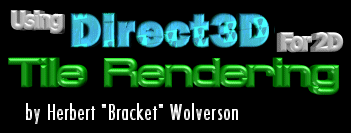11/10 - 11/12 @ Montréal, Canada
12/5 - 12/7 @ Shanghai, China
12/24 - 12/27
2/28 - 3/4 @ San Francisco, CA
More events...
2406 articles in the reference section.
Help us fight cancer!
Join SETI Team GDNet!

|
IntroductionIsometric and tile-based games have been around for a very long time. Rendering techniques for this type of game have grown considerably in sophistication since then, but the style itself remains popular. While some have argued (vocally!) that the arrival of 3D graphics will render 2D (and "psuedo-3D") rendering techniques obsolete, there is good reason to believe that if this is the case - it will not be true for some time. For one thing, writing a dynamic 3D engine is difficult - hard enough to be prohibitive for small development groups. Until 3D graphics hardware matures, compatibility remains an issue. Likewise, until the average 3D card can handle a significantly higher polygon throughput than today, 3D graphics will not always look significantly better than a well-planned tile-based game. 3D-renderers do, however, offer 2D graphics a significant boost in performance. After all, all a "3D card" does is spit out textured polygons at high speed - something that can seriously slow down a non-accelerated rendering routine. Alpha blending, texture mapping, gouraud shading and other features have all been implemented in 2D routines - but a 3D card offers the potential to make them fast enough for regular use. This article describes the use of Direct3D to enhance 2D graphics - and suggests that nicely lit tile-based engines are within everybody's grasp. Tile-based and Isometric Views A significant volume of material has been written on both tile-based and isometric rendering. The "diamond tiles versus square tiles" argument has raged across many forums for years, with both sides having advantages. This article will focus on diamond-shaped tiles, largely because of author preference (they look nicer!) It should be relatively easy to switch to a square tile rendering engine using these techniques. Jim Adams' Guide to Isometric Engines gives a great overview of this kind of isometric rendering: Traditional MethodsTraditionally, diamond tiles have been something of a pain. Tiles needed to be designed as diamond-shaped bitmaps, usually with a color-keyed background. It could be extremely different to make tile boundaries appear seamless. Additionally, the programmer was faced with a fair degree of overhead: the color keyed area of each bitmap had to be ignored during the blitting process. Many innovative ways of reducing this overhead exist (and many artists have proven innovative in tile design), but the fact remained: isometric rendering was tricky. How 3D Architectures Can Help3D cards are in many ways ideally suited to rendering diamond-tile based isometric views. Textured triangles, the staple of 3D engines, require the application of bitmaps to odd-shaped regions. Diamonds break down simply into two triangles (as do any other quad), so there is no difference in raw blitting overhead between square and diamond tiles. The artist's life is made easier, too: textures in 3D engines are typically rectangular, and are mapped to fit polygons. Thus, artists are able to design square textures (which tend to tile much more nicely), and let the 3D hardware worry about making it look good when stretched over a diamond-shaped tile. Additionally, height-mapping and other concerns become significantly easier to implement because a textured quad, unlike a static bitmap, may be readily warped. Note: Most 3D accelerators are really 2D accelerators. With the exception of some new ones that help with transformation & lighting, all these cards can do is pump out textured triangles - onto a 2D surface. Thus, there is absolutely nothing unnatural about using a 3D card to speed up 2D rendering - in fact, its just doing what the card always does, without some heavy matrix math! Some AssumptionsThis article assumes a working knowledge of isometric/tile-based graphics. If you are unsure of how these work, you are advised to check out the bibliography for more information. While plenty of information is given on implementing an isometric engine, this article doesn't take the time to introduce the basic concepts. Sorry! This article also assumes a basic knowledge of DirectDraw (not Direct3D) and Windows programming. There are many tutorials on these on the Internet. André LaMothe's book Tricks of the Windows Game Programming Gurus makes an excellent starting point for learning these subjects (and many others). |
|||||||||||
|
|
|||||||||||